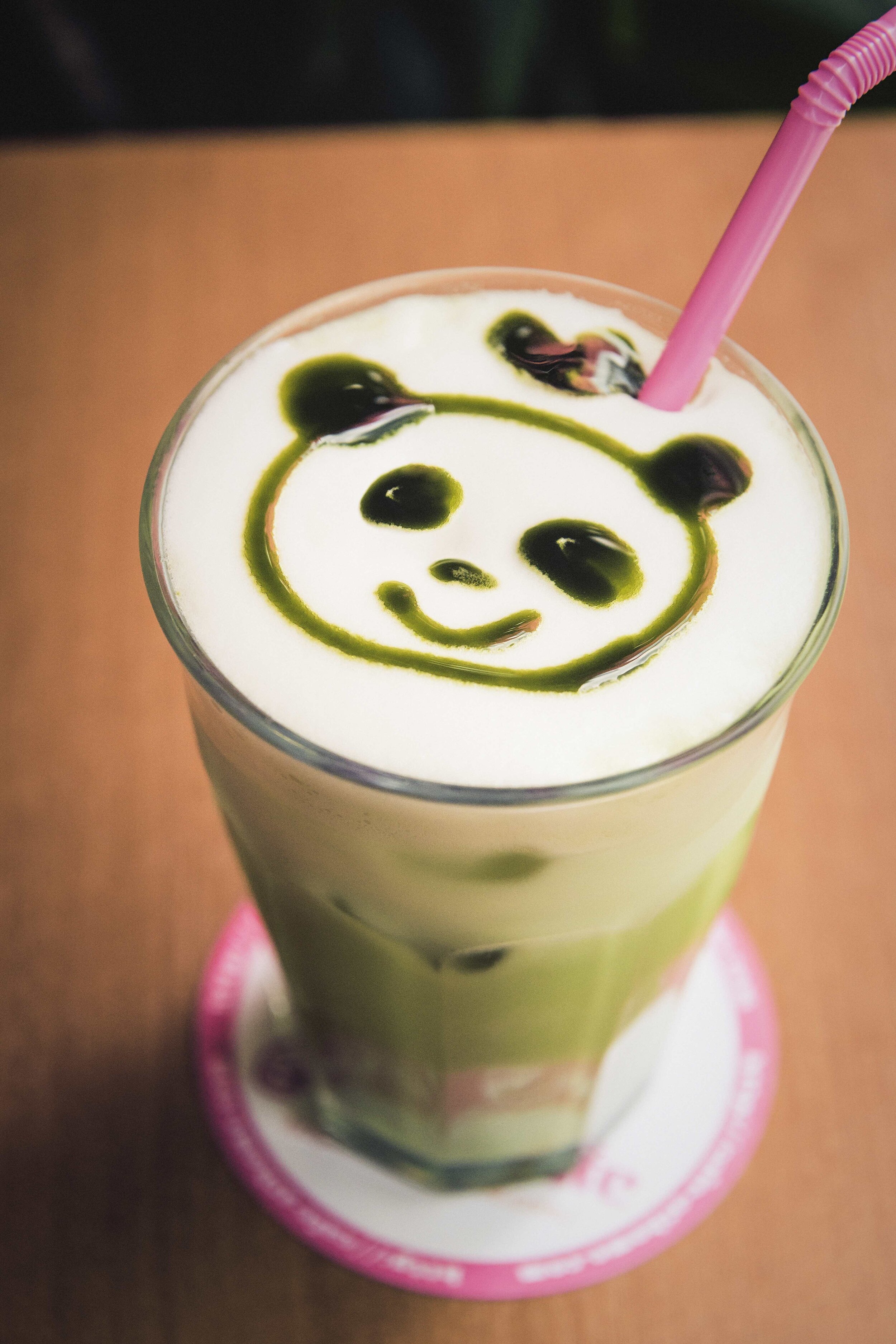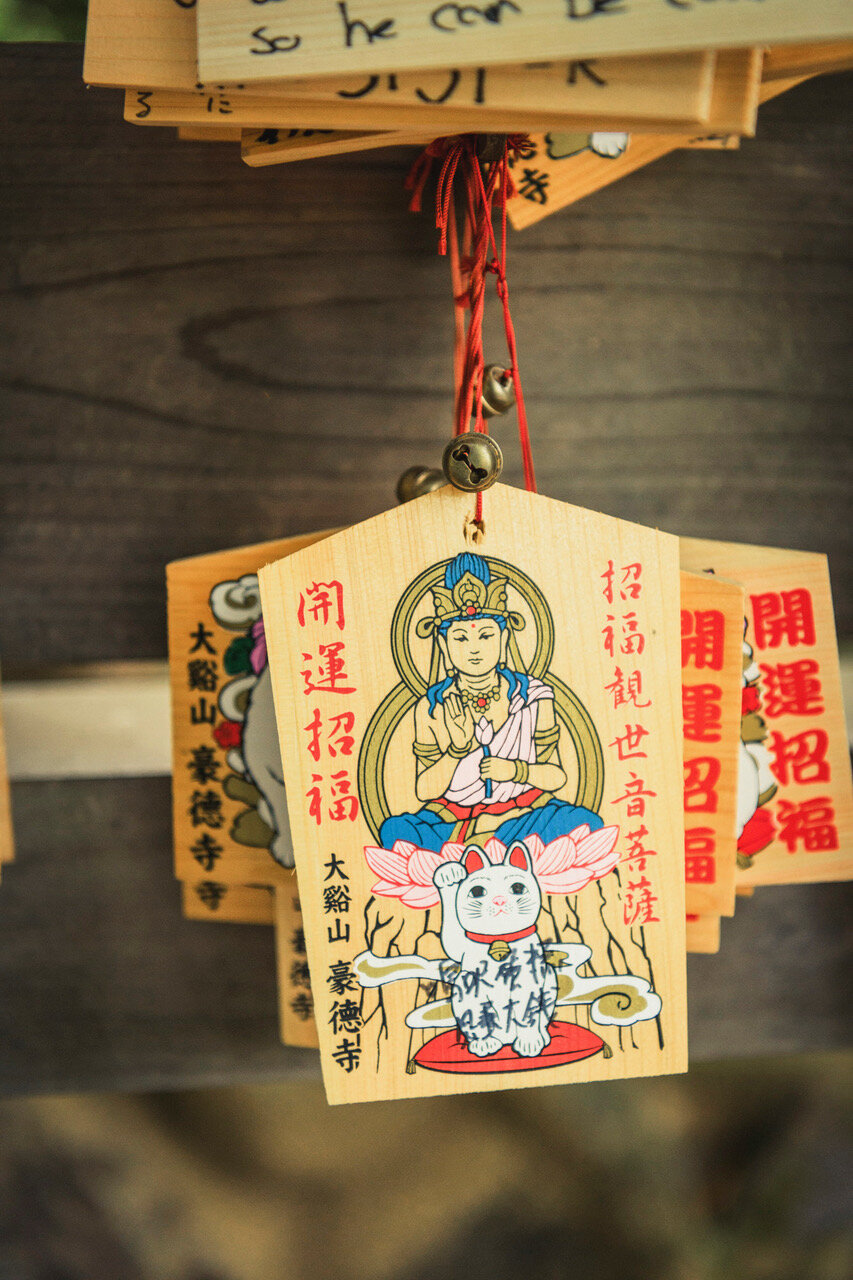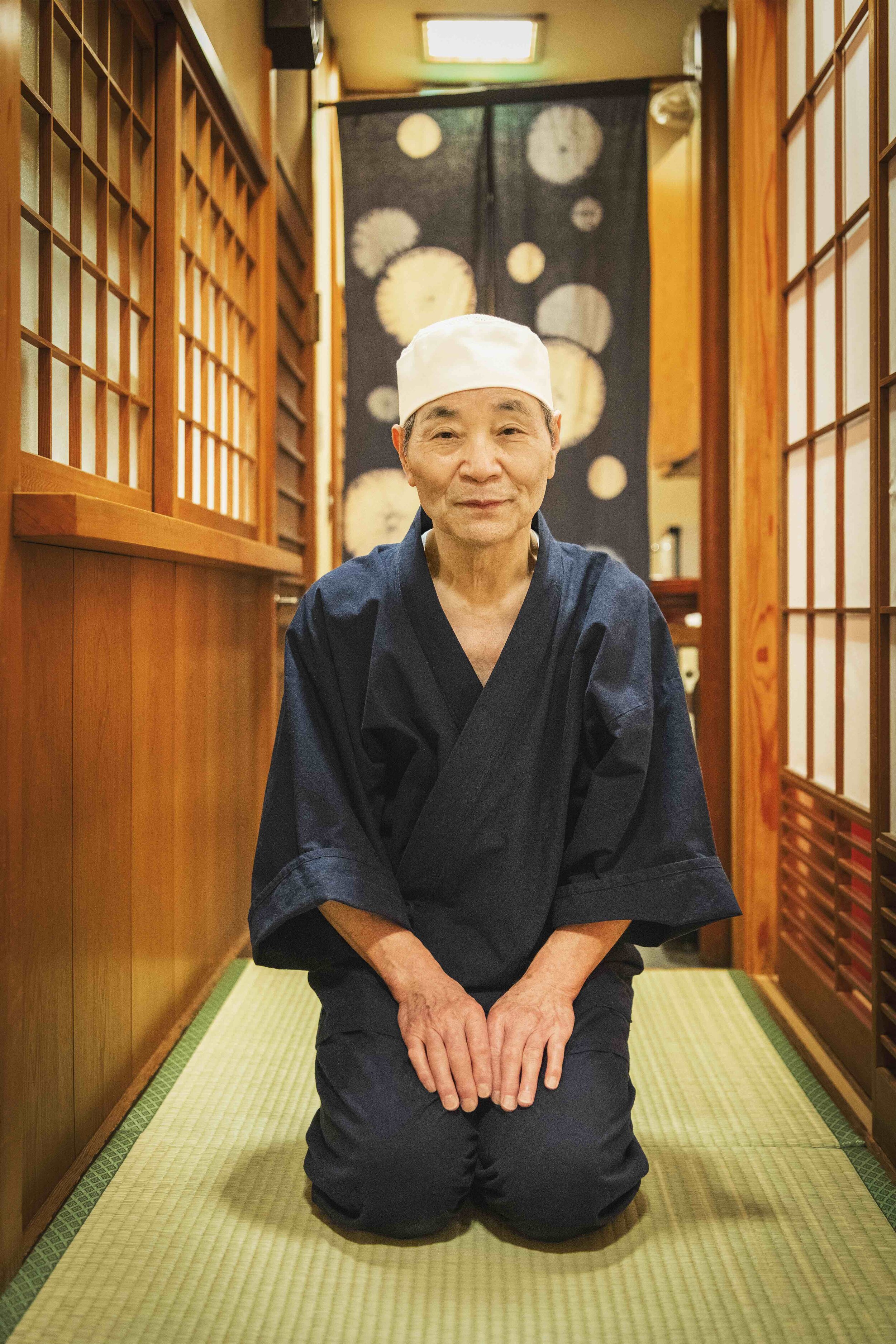
ONLY IN TOKYO
If you can think of it, you can probably do it in Tokyo – join us in seeking out the bizarre in the Japanese capital, a city like no other
All images by Jonathan Stokes
1. Embrace cute
‘Welcome home!’ trills the staff in unison on entry to the @home cafe, one of an estimated 200 ‘maid cafés’ in Japan. The venue takes up four floors of a building in Akihabara, the motherland for lovers of anime, manga, cosplay and video-gaming. Though the short skirts and stockings worn by the maids suggest something else (not least a somewhat sketchy relationship with gender equality), the cafés are temples to the cultural phenomenon of kawaii, a love of all things cute. The maids resemble anime characters, head-to-toe in pastels, frills and bows, and their pupils widened with special contact lenses. ‘You have work and stress in real life,’ says Ms Hitomi as she diligently draws a panda face in the froth of a Magic Iced Green Tea Latte, ‘and you can come here and everyone is always happy and full of energy. It’s an escape.’ Young couples, tourists and a good number of teenage boys are happy to dive in, challenging a maid to a game of Hungry Hungry Hippos, clapping along to some astonishingly high-pitched singing, or ordering a Cute Puppy Curry Set from the heart-shaped menu. Then it’s back on to the street and real life, pleasantly baffled
and wondering what the hell just happened.


2. get lost down alleyways
It’s a familiar sight along the alleys of Tokyo. Work has ended for the day, and a lone salaryman, tie pulled loose, wanders the lane, peering into the bars that squeeze along it. At the end of the alley, he turns around and repeats the process. Finally, a decision is made, a venue is picked and in he goes, his evening sorted until it’s time to catch the train home. Tokyo’s yokochō (alleys) each have their own character, and many sprouted up illegally after WWII, specialising in the trade of black-market goods, prostitution and other illicit activities. The eight lanes of Golden Gai are officially home to 229 bars, though unofficial figures put the number closer to 300. Few are bigger than a shed, with three or four stools lined up at the counter, and customers here to drink and make friends. (‘People are shy in Japan and wear a mask,’ says events manager Yū as she sips tequila at miniscule Saru bar, its shelves crammed with LPs, ‘but not here in the alleys.’) Despite their nicknames, the focus on Omoide Yokocho (Piss Alley) and Nonbei Yokocho (Drunkards’ Alley) is more on eating than boozing. Drawn by the smell of barbecue, people pick their way along lanes cluttered with beer crates and lit by paper lanterns, to find a perch at their chosen restaurant. Beer ordered, cigarette lit, there’s just one more choice to make: will it be a bowl of ramen or a plate of barbecued pork belly, ordered with a side of crispy chicken skin or fried pigs intestines?


3. drink beer AND
GET A MASSAGE
If you tire of the all-out onslaught that defines central Tokyo, Yanaka district is the place to decompress. Here, people trundle about on bicycles, cats loll in doorways, and buildings are low-rise and contain art galleries, stationery shops and temples. On a side street off a side street lies Uenosakuragi-atari, a cluster of wooden buildings built in 1938, restored in 2015 and now protected by a preservation order. The complex is home to an olive-oil shop, florist, bakery and beer hall, fronting a courtyard designed to induce maximum Zen. At Yanaka Beer Hall, customers sit with glasses of craft beer, reading books and listening to the jazz playing in the background. Owner Hitomi Yoshida brings over a flight of the hall’s own brews, made using water from Mount Fuji. ‘This place is traditional Japanese style, very relaxing,’ she says, ‘but we serve modern beer.’ She points to her favourite, the Yanaka Beer Hall Original Lager, which has a smooth malty taste and is served only here. ‘Craft beer is becoming more popular in Tokyo,’ she continues. ‘People like to drink the beer where it was made.’ Once slightly sloshed, punters can head upstairs and plonk themselves in a hammock, where reflexologist Futoshi Kikukawa is on hand to deliver a head massage. It may be time for a doze.


4. SHOP niche
The Japanese word shibui (simple beauty) might have been invented for the goods sold at Saruya. On a quiet backstreet in the commercial district of Nihonbashi, Saruya sells toothpicks, and nothing else. There are thickly hewn beasts, delicate little spindles, machine-produced bundles and samurai toothpicks hand-carved from spicebushes. Each is beautifully presented in a wooden box, rice-paper bag or delicate fabric wrap. No toothpicks are needed for the food created on Kappabashi St. Many of the shops here specialise in sampuru, fake food made from wax, plastic or resin, displayed in restaurant windows to entice customers through the door. Fake chefs can pick up a bowl of plastic chicken katsu or a piece of plastic sushi, or take home a kit and have a go at making something inedible themselves. Continue the theme of familiar food stuffs not being quite what they seem to be by heading to one of Tokyo’s many KitKat Chocolatory shops. The Japanese go wild for a flavoured KitKat, and Nestle has produced some 200 different types over the years. Alongside premium high-cocoa bars, on sale are KitKats infused with wasabi, strawberry maple and banana,


5. play with monsters
To get to the Mushroom Disco, you must first enter the stomach of Mr Ten Thousand Chopsticks and pass the Sweets-Go-Round carousel, nodding to a unicorn and a Pikachu as you go. Once you’re positioned beneath a technicolour fungus, a monster girl will take your order, perhaps Colourful Rainbow Pasta followed by Poison Parfait Extreme. No, you haven’t inadvertently inhaled an irregular substance - this is the Kawaii Monster Café, which has taken the Japanese love of kawaii (cute) and made it punk. ‘This is modern kawaii,’ says Crazy Monster Girl as she delivers a teetering stack of ice-cream. ‘These bright colours, they’re like poison for Japanese. It’s not traditional at all.’ Two hundred people turned up to audition for the monster girls when the café opened in 2015, and Crazy is just one of five to make the grade. They stage several dance shows a day – but you may be too distracted by the jellyfish looming over the bar or the giant rabbit drinking from a bottle of milk to notice.


6. worship cats
There are hints of what’s to come on the walk from the station to Gōtokuji temple. On the windowsills and doorsteps of shops and houses, small ceramic cats perch, one paw raised, beatific expressions on their faces. Inside the temple grounds, a wooden pagoda stands three storeys high, surrounded by maple, gingko and cherry trees, their leaves dripping water in the soft rain. Beyond it, it becomes clear how Go¯tokuji got its nickname: the Cat Temple. Wherever there is space to put a cat, there is a cat: on shelves, tucked into shrines, on paving slabs, in tree branches. Some are no bigger than a fingernail, others are knee-high. According to legend, in the 17th century during a storm, Lord Naotaka Ii saw a cat beckoning him to join him at this site; while he stood with the cat, lightning struck the place he had been standing, and as a sign of gratitude, he built the temple. It is still considered a lucky place. ‘Many people come here because they have a wish, maybe for a happy marriage or they want to be a doctor,’ says guide Ms Yumiko Komatsu, sheltering beneath an umbrella. ‘They bring a cat and make their prayers. They come back and thank the cat if it came true.’ To help prosperity along, there are cats on sale in the information centre – just find a place to put it, and make a wish.


7. Meet godzilla
Something is stirring in Shinjuku. A monster is awakening on the eighth floor of the Hotel Gracery. It comes to life with a terrific roar and is soon flashing red eyes and breathing smoke, causing people on the streets below to turn their heads upwards in mild alarm. Godzilla has lived on the tower since 2015 and sparks into life on the hour, bringing hotel guests scurrying to the terrace. Most cower beneath it – but one man stands defiant, hero of his own imaginary action film, and lets Godzilla do its worst.


8. eat the food
of monks
Down an unassuming street in the residential district of
Azabu-Juban lies a discrete door, partly obscured by pot plants and noren curtains, behind which some of Tokyo’s most intriguing food is served. Itoshō specialises in shōjin ryōri, the vegetarian and vegan food traditionally eaten in Buddhist temples. Sprightly nonagenarian chef Hiroharu Itō welcomes guests and, once their shoes are removed, shows them to one of three rooms divided by paper screens, seating them on tatami mats at low tables. What follows is a multi-course Michelin-starred menu of mystery, each dish a delicate artwork on the plate: bright green slices of matcha jelly served with swirls of creamed tofu; deep-fried vegetables coated in puffs of rice flour; soba noodles with seaweed and wasabi. In a city where pig rectum and horse-meat sashimi are fairly easy to get hold of for dinner, it’s quite the revelation.


9. spend the night
with robots
Were Liberace alive today, he’d be a big fan of the lounge-bar at the Robot Restaurant in Shinjuku. There are gold chairs in the shape of shells, swirly patterned carpets, whirling rainbow lights, mirrored walls and ceilings, and a band of droids in the corner singing Backstreet Boys covers and Disney medleys. It’s a lot to take in, but this is just the warm-up to the main event: the Robot Show. Several times a day, an audience made up largely of out-of-towners is ushered to the main performance space, taking their seats either side of a long central stage. What follows for 90 minutes is likely to leave all of them slightly dazed in wonderment. Drummers ride in on dragons, girls swish swords atop giant prawns and are eaten by giant snakes, Transformers do battle with one another in a blaze of lasers, and gangly-legged parrots dance on top of cheerful chickens. One of 40 professional dancers, Ms Nene Kinoshita has worked at the Robot Restaurant for four years. ‘I decided to become a performer when I came here for the first time,’ she says. ‘The show unfolding in front of my eyes was totally unexpected. Tokyo is full of unique and colourful people who are not afraid to try new things, and this is one of them.’ Her favourite part of the show is the knowledge that she has become part of visitors’ memories of travelling in Japan. As with much in the city, once experienced, there’s little chance of anyone forgetting it.


This feature first appeared in the November 2019 issue of Lonely Planet magazine. All copyright owned by Lonely Planet.